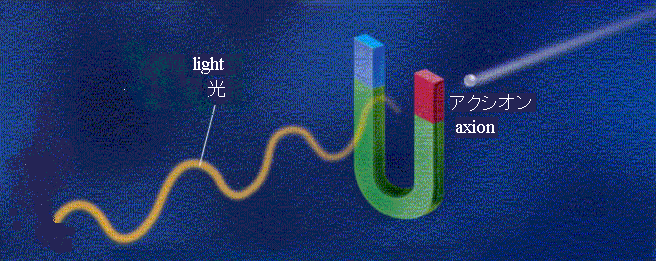
MINOWA Group |
みのわ研究室 |
Solar axion search experiment with a superconducting magnetThe axion is a light neutral pseudoscalar particle yet to be discovered. It was introduced to solve the so-called strong CP problem. The expected property of the axion is characterized mostly by its mass, ma. If 10-5<ma<10-3eV, the axion can be copiously produced in the early universe so that they can close the universe as dark matter. Another astrophysically interesting mass region is at around one to a few eV. Such axions can be allowed for some hadronic axion models by other astrophysical or cosmological constraints. In this region, the axion would be produced in the solar core through the Primakoff effect. It has an energy spectrum very similar to that of black body radiation photons with an average energy of about 4 keV. It can be converted back to an x-ray in a strong magnetic field in the laboratory by the inverse process. The principle of the detection is illustrated in the following figure. |
超伝導電磁石による太陽アクシォンの検出実験強い相互作用を記述する量子色力学には「強い力のCP問題」という矛盾が残されている。それを解決するアクシオン模型においては、電気的に中性でスピンが零、負のパリティをもつアクシオンの存在が予言されている。30年近く実験的探索の努力がなされてきたが、まだ発見されていない。アクシオンの性質は、その質量maによってほとんど決まる。質量が10-5<ma<10-3eV程度の範囲にあれば宇宙創生期に大量に作られて現在は暗黒物質として残っていると考えられている。 一方、質量が多少重くて1〜数eVの程度であれば、太陽の中心の平均約4keVの黒体放射の光子と原子核または電子との間の反応(プリマコフ効果)により大量に作られる。太陽で作られたアクシオンは、宇宙空間を飛行して地球まで到達する。このような太陽アクシオンは、地上の実験室の磁石の作る強い磁場によってふたたびX線(光子)に変換されて検出できるようになる。 |

| We constructed a long superconducting magnet
called the axion helioscope to search for the solar axions. A schematic
view of the helioscope is shown in the next figure.
It consists of three parts, a tracking system, superconducting coils and x-ray detectors. The magnetic field strength in the aperture is 4 T. The tracking system is an altazimuth mount and drives a 3-m long vacuum cylinder of the helioscope to track the sun. Its trackable altitude ranges from -28 degrees to 28 degrees and almost any azimuthal direction is trackable. This view range corresponds to about 50% of duty cycle for the sun measurement in Tokyo. The other half of a day we measure the background. This helioscope mount is driven by two AC servo motors controlled by a personal computer (PC) through CAMAC bus. The PC regularly monitors two precision rotary encoders through CAMAC bus and forms a feedback control loop. The superconducting coils and the x-ray detectors are mounted in the cylinder. The coils are kept at 5-6K during operation. They are directly cooled with two Gifford-McMahon refrigerators and no cryogen is needed. |
我々は、太陽アクシオンを検出するため、下図のような全長約3mの超伝導電磁石で中心磁場4Tを発生するAxion
Helioscopeを作った。
この装置は、太陽追尾のためにコンピュータ(パソコン)制御された経緯儀の上に据え付けられている。経緯儀は上下各28°、水平面内はほぼ360°回転できる。この仰角・俯角範囲で追尾すれば、東京の緯度では年間平均で約50%の時間太陽を観測することができる。残りの時間は太陽以外の方向に向けてバックグラウンド測定をする。 筒の中には超伝導コイルとX線検出器が入っている。コイルは2台のGifford-McMahon冷凍機により直接約5-6Kに冷やされるので、液体ヘリウムなどの寒剤は必要としない。 |
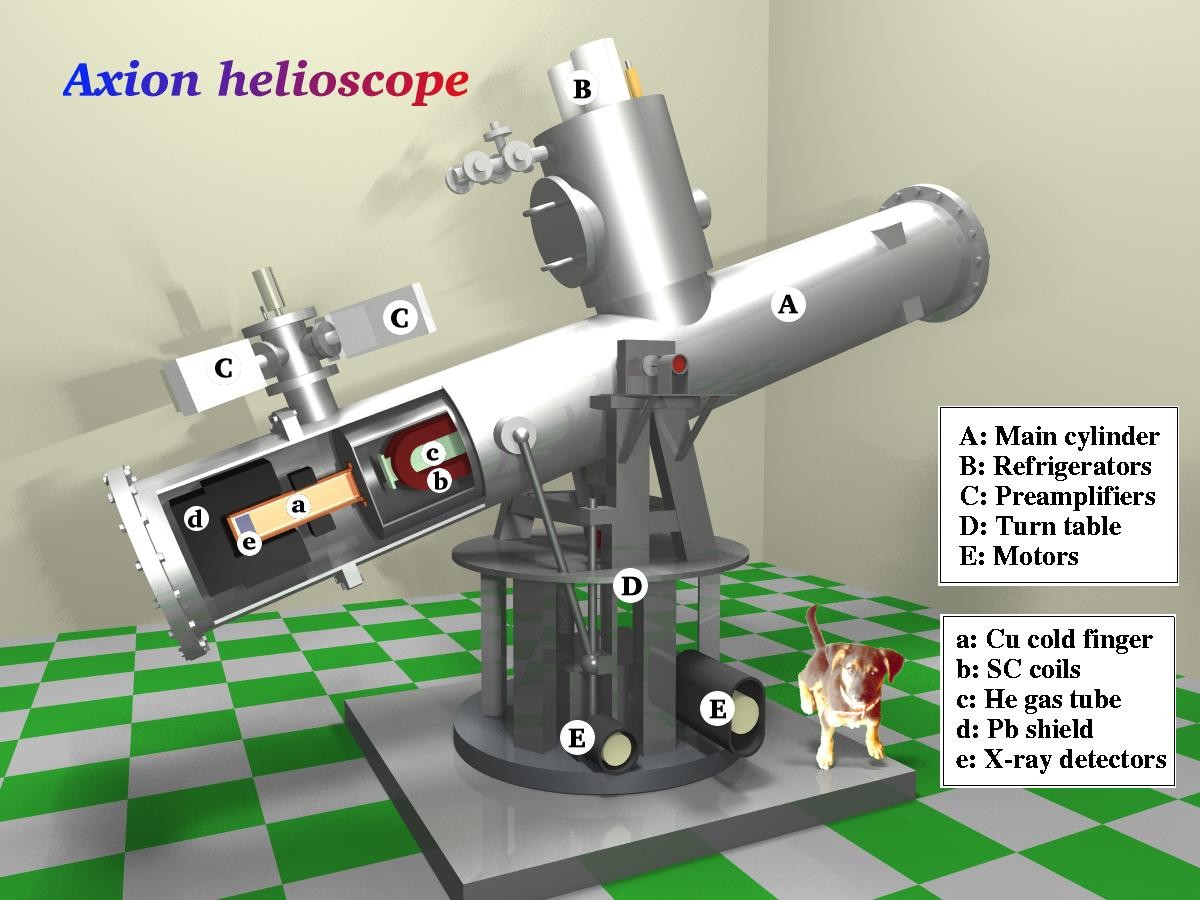
| Sixteen PIN photodiodes, Hamamatsu Photonics S3590-06, are used as the x-ray detectors. The chip size is 11x11x0.5mm3. The x-ray detectors are mounted in a thermal as well as radioactive radiation shielding box made of oxygen-free high conductivity copper (OFHC Cu) which is operated at about 60K. The following picture shows a unit of four PIN photodiodes with their front-end amplifiers. | X線検出器としては、本来光センサーである浜松ホトニクスのPINダイオードS3590-06を16枚用いている。1枚の大きさは11x11x0.5mm3である。この検出器は熱兼放射線遮蔽用の無酸素銅の箱に収められ、温度約60Kで作動している。次の写真はフロントエンドアンプとPINダイオードを4組のユニットにしたものである。 |
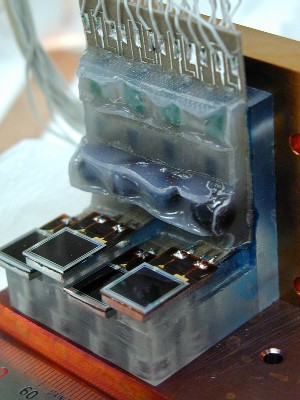
| We put limits on axion-photon coupling constant
by the search for the solar axions with the Axion Helioscope. The limits
are illustrated in the following figure. Our limits are more stringent
than any existing experimental limits in this mass region, and also than
the limit inferred from the solar age consideration and also more
stringent than the recent helioseismological bound. These results are
described in the latest
publication.
In the next phase of the experiment, we try to go to still higher mass toward the region upto ma=2eV. |
これまでの観測の結果、アクシオンは未発見であるが、下図に示すようにアクシオンと光子の結合定数に対して制限をつけることができた。この制限は、この質量領域では既存のどの実験よりも厳しいものである。また、これまで太陽の年齢に対する考察からつけられていた制限をはじめて超えた結果でもある。さらに新しい太陽震に関する研究からつけられた制限をも越えている。詳しくは、最近の論文を参照。
我々は、次の段階ではさらに大きな質量をねらい、2eVまでの質量領域についてアクシオン探索を行なうことにしている。 |
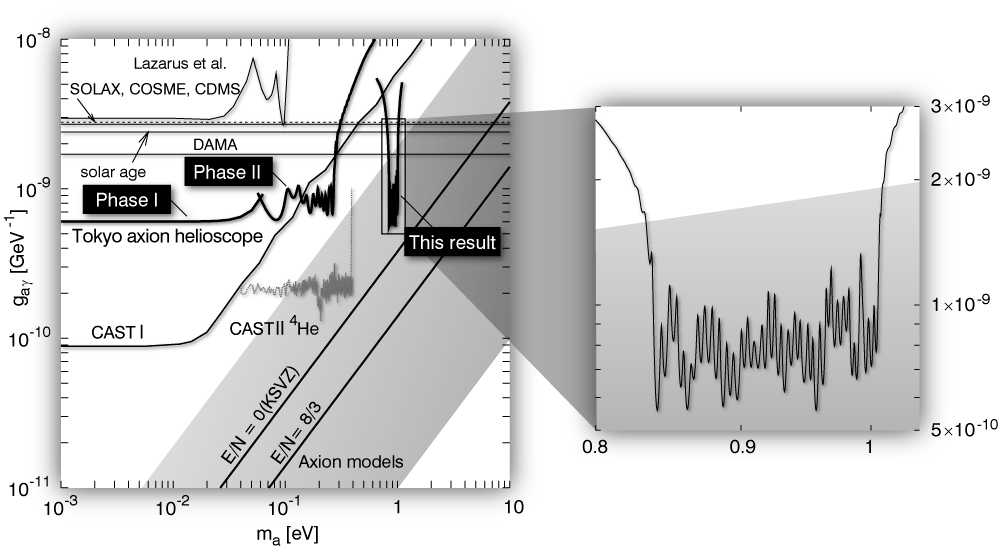
| As published in our resent report, the AXION HELIOSCOPE has also been used to search for possible axions emitted by other celestial objects. We scanned about 10% of the celestial sphere as shown in the following figure and searched for point axion sources. We also searched for axions from four compact objects, the galactic center, Sco X-1, Vela X-1, and Crab nebula. The AXION HELIOSCOPE is further directed toward the soft gamma ray repeater SGR 1900+14 to search for axions produced in it with its very strong magnetic field. No positive signal is found so far, and we put limits on the axion flux coming from them for the first time. | Axion Helioscopeは太陽以外の天体でも、axionを放出する可能性のあるものを同様に観測することができる。太陽の場合と同様な議論で、いろんな天体から飛来しているaxionのフラックスも計算されている。われわれは、これまでに下図に示すような全天球の10%をスキャンして、axionの点源を探した。また、銀河中心、Scorpius X-1、Vela X-1、Crab nebulaをそれぞれ追尾観測した。また、大変強い磁場を持つと考えられているsoft gamma ray repeater SGR 1900+14についても追尾観測を行っている。いずれも、negative resultであるが、axionフラックスの上限値を与えている。結果の一部は、最近のわれわれの論文に報告されている。 |
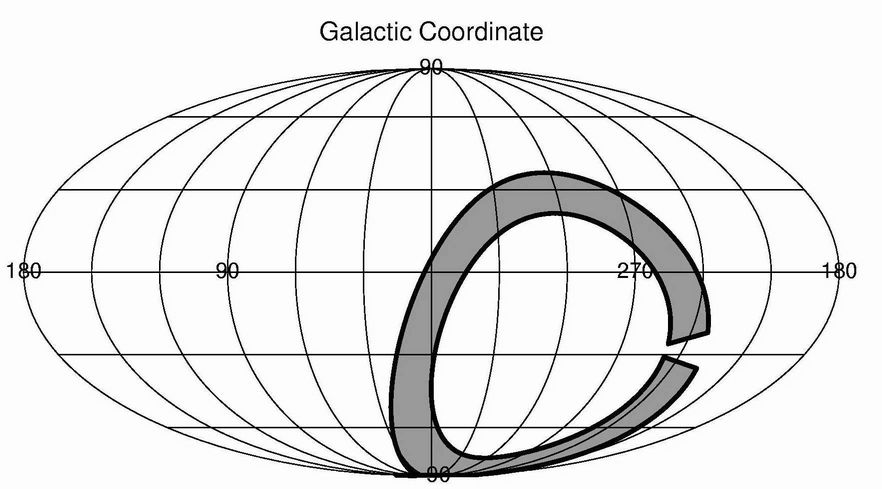
Last maintained
on 2010-08-19
by ![]()